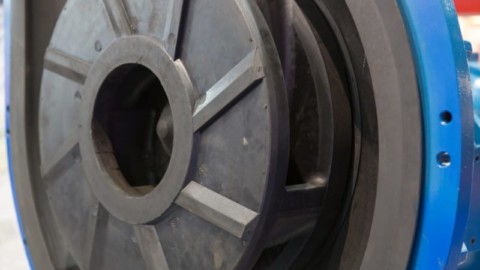By Malcolm Robertson, Managing Director, Robertson Technology Pty Ltd, Joondalup, WA
Many organisations are attempting to improve the energy efficiency and reliability of their pump systems, and to verify and maintain the energy (and carbon) savings. This requires accurate measurements, in particular before and after any improvements.
The thermodynamic method often provides the most accurate on-site measurement of pump performance, for both individual pumps and the overall pump system. In many cases the uncertainties in pump efficiency and flow rate are less than 1 and 1.5 {87a03eb4327cd2ba79570dbcca4066c6d479b8f7279bafdb318e7183d82771cf} respectively.
Temperature and pressure probes are required before and after the pump, to measure the differential temperature and pressure. The efficiency is determined from this information plus the thermodynamic coefficients for the fluid (for water, these coefficients are readily available from international standards such as ISO 5198 – Precision class tests). The flow rate is then derived from the efficiency, head, and power to the pump.
The performance of an instrument employing the thermodynamic method is largely determined by the design, accuracy and long-term stability of the temperature probes, since it is often required to measure the differential temperature across the pump to an accuracy of 0.001°C (1 mK).
Long-term tests have shown that the calibration of Robertson Technology temperature probes is typically stable within an experimental error of <0.2 mK over a five-year period. Each probe contains two temperature sensors. Software detects any discrepancies between the two sensors, giving a warning if one of the sensors starts to drift. The probes are thus suitable for permanent installations for continuous monitoring.
Techniques used are
- Individual pump testing with a portable unit (Robertson P22P Pump Monitor)
- Simultaneous multi-pump measurements with a portable unit
- Continuous monitoring with fixed units (Robertson P22F Pump Monitor) on every pump in a pump system
Theory
For a rotating device such as a pump, blower, or turbine, there are four main performance variables. These are efficiency, flow, power, and head, and they are linked by ‘The Pump Equation’. Knowing any three, the fourth can be found.
For an electrically driven pump: ηp.ME.PW = q.ρ.g.H
The left-hand side is the electrical power (watts, or joules per second) applied to the fluid, after losses in the motor drive and pump: –
ηp is the pump efficiency (expressed as a fraction)
ME is the motor and drive efficiency (expressed as a fraction)
PW is the electrical power to the motor (in watts)
The right-hand side is the energy per second imparted to the fluid, and also has the units of watts (joules per second): –
q is flow rate, in m3/s
ρ is the fluid density, in kg/ m3, and is a function of temperature and pressure
g is the acceleration due to gravity, in m/s2
H is pump total head, in m
The terms ρ, g, H, PW and ME are common to all pump test methods, with ρ and g being obtainable from reference tables, and ME supplied by the motor manufacturer.
With the thermodynamic method, pump efficiency ηp and total head H are measured by temperature and pressure probes, and motor input power PW is measured by a power meter. Thus the flow rate q can be found thermodynamically without a separate flow meter, and with low uncertainty, since it is relatively easy to check the calibration of the temperature and pressure probes, and the power meters:
q = ηp.ME.PW / ρ.g.H
Thermodynamic vs conventional
On-site constraints often make it difficult to accurately measure pump efficiency under installed conditions by the same method that pump manufacturers traditionally use for works tests. In the conventional technique, pump efficiency is calculated from the Pump Equation as follows:
ηp = q.ρ.g.H/ ME.PW
This requires measurement of flow rate, head, and power. The accuracy of the pump efficiency measurement is determined by the errors in the measurement of q, H, PW, and Me.
In practice, the flow rate, q, is the most difficult to determine accurately. Many pumps do not have accurate, individual flow meters, which are high cost items, especially for larger diameter pipes, and can be difficult or impossible to install, maintain, and carry out calibration checks on-site. Flow meter accuracy can be dependent on installed straight, clear pipe lengths prior to and after the measuring device, the pump’s operating point and other factors, such as build-up of debris in pipes or on sensors. Often, just the total flow from the station, or from each group of pumps, is measured. Pipe installations may be compromised in the interest of minimising civil costs.
Conventional flow meters, either installed or strap-on, are likely to have an accuracy of 5 to 10{87a03eb4327cd2ba79570dbcca4066c6d479b8f7279bafdb318e7183d82771cf}, and this will lead to corresponding errors in the pump efficiency measurement. These errors are so large that the conventional method is impracticable for accurate measurements of energy savings, or for pump refurbishment or system control decisions.
Additionally, pumps operating in parallel need individual flow meters for continuous monitoring to be meaningful.
The thermodynamic method has the following advantages:
- Pump efficiency and flow rate are accurately measured
- The flow rate measurement is independent of velocity profile
- Measurement is accurate even when pumps are cavitating, or when there is air entrainment (this is because the thermodynamic method measures mass flow rate, and converts to volumetric flow rate using the fluid density. In contrast, many types of conventional flow meter will also respond to water vapour or air bubbles)
- Calibration depends primarily on temperature, pressure, and power measurements, and can be checked on-site
- Each pump has its own flow meter, so pump systems can be optimised for efficiency and flow rate. This is particularly important for energy savings when pumps are operating in parallel.
Measurement of temperature and pressure
With portable units for snap-shot measurements, immersion temperature probes are generally used, protruding 50 mm into the fluid flow. These require tapping points before and after the pump, in pipe work.

Figure 1. Portable probes
Figure 1 shows immersion temperature probe passing into fluid via a T-piece and gate valve. A pressure probe is also attached to the T-piece. A constraint is that the unsupported length of the temperature probe should be within certain limits, depending on the water velocity, to avoid vibration and excessive stress due to vortex shedding.
For continuous monitoring, and for high temperature and pressure applications, the temperature probes are inserted via thermowells, and are fitted separate to the pressure probes (see Figure 2). This minimises vibration and long-term stress, as the unsupported length of the temperature probes can be quite short.
Two other methods of measuring differential temperature, water sampling, and surface temperature sensors, have been developed for applications where it is not possible to fit standard tapping points. However, there are some constraints on their use.

Figure 2. High power pump fitted with fixed unit for continuous monitoring.
The higher the total head, the higher the differential temperature signal, and the more accurate the measurement. Similarly, the lower the pump efficiency, the higher the differential signal, and the more accurate the measurement. So the worse your pump is, the better we can measure it!
As a rule of thumb, the uncertainty in pump efficiency measurement will be less than 1{87a03eb4327cd2ba79570dbcca4066c6d479b8f7279bafdb318e7183d82771cf} for total head above 20 m. The uncertainty in the flow rate will always be a bit higher, as it will include the uncertainty in the pump input power measurement.
Techniques have been adapted to test vertical pumps in wet-wells. These take longer to test, as much more data has to be collected, and filtered for stable suction temperatures.
Speed control
We are able to interface tachometers with the P22, and obtain speed in real time, also correcting data dynamically on the basis of the affinity laws.
In a parallel pump system, all pumps must be well-matched, otherwise the weaker pumps will be forced towards shut-off. If VSDs are installed, they should be fitted to all pumps, and speeds adjusted for optimum performance. A pump fitted with a VSD cannot cost-effectively be used as a ‘top-up’ pump with fixed speed pumps in parallel.

Figure 3. Efficiency vs flow rate at different speeds
Figure 3 demonstrates that efficiency is largely unaffected by speed changes, as would be expected from the affinity laws. Manufacturer’s data for this 5 MW pump was taken in 2007. Five years later we measured pump performance over a range of speeds. The peak efficiency has degraded but does not vary with speed; flow rate alters with speed.
Future developments
Continuous monitoring will naturally identify the most opportunities for energy savings, as the full range of operational conditions is thereby covered. Rapid deterioration in pump performance, changes in system curve, cavitation, and control system limitations could occur at any time. We expect many more installations, with interface to SCADA, and emphasis on pump system optimisation for energy and carbon savings.
The repeatability of pump efficiency measurements is typically 0.2{87a03eb4327cd2ba79570dbcca4066c6d479b8f7279bafdb318e7183d82771cf}, so early detection of potential problems is possible with continuous monitoring.
The thermodynamic method can be extended to hydrocarbons, but the equipment required is more complex and requires hazardous area certification.
Applications
Robertson Technology has been developing the thermodynamic method since 2001, with the assistance of several federal and state grants, and we have clients in 14 countries, including major pump manufacturers. Over 90{87a03eb4327cd2ba79570dbcca4066c6d479b8f7279bafdb318e7183d82771cf} of world pumps are in the Northern hemisphere, so we travel.
Here are the main applications that we have been involved with, and the corresponding countries. Over 95{87a03eb4327cd2ba79570dbcca4066c6d479b8f7279bafdb318e7183d82771cf} of our business is with water utilities and power stations.
- Water and wastewater utility pumps (Australia, New Zealand, UK, USA, Canada, Singapore, Malaysia, Greece, Spain, Philippines, India, South Korea, Hong Kong): Pump motor power varied from a few kW to 5 MW. We are often testing multiple pumps in parallel. Cavitation is seen quite regularly. We have installed a number of fixed systems for continuous monitoring of pumps in parallel, and pump system optimisation and scheduling (Australia, USA, India, and Hong Kong).
- Coal and gas power stations (Australia, New Zealand, UK, Hong Kong): Boiler feed pumps up to 8 MW (requiring higher temperature and pressure ranges), condensate extraction, cooling water, fire pumps.
- Nuclear power stations (USA): Circulation pumps. The water velocity was quite high and we used a water sampling method. Soon we will be testing other types of pump.
- Air blowers (Australia): These required development of slightly different range probes. We’ve also compared immersion and surface temperature measurements.
- Desalination plants (Australia, Spain): We are able to test pumps in all stages of the process.
- Irrigation pumps (Malaysia): Low head vertical pumps in wet wells. Cavitation often seen.
- Offshore rig (Malaysia waters): Sea water lift, heating medium, cooling medium, and fire pumps. We used surface temperature sensors as there was no way of inserting tapping points.
- Marine (UK): Surface and subsurface vessels. We compared immersion and surface probes.
- Hydro-turbines (Romania): Turbines are generally measured according to IEC 60041 standard.
About the Author
Malcolm Robertson grew up in Zambia, then originally trained as a physicist, obtaining a PhD in thermoluminescence dosimetry from the University of Surrey, UK. The development of instrumentation for ionising radiation, nuclear medicine, and XRF mineral analysis gave him experience in temperature measurement, analogue electronics, and mechanical design which has now been applied to the thermodynamic method for energy efficiency and flow rate measurements.
He relocated from the UK to Perth in 1990, for lifestyle reasons. Robertson Technology has supplied instrumentation and test services internationally for pump, blower, and turbine performance measurements, since 2002.















